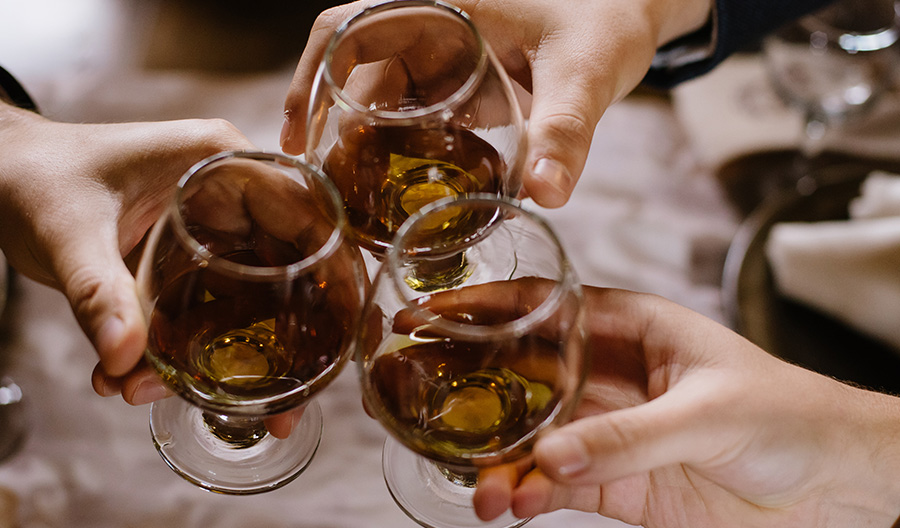Spanish brandy, known locally as 'Brandy de Jerez', is a distinctive spirit that is produced exclusively in the Sherry Triangle, an area in the province of Cadiz. This region's unique climate, characterized by hot, dry summers and mild, wet winters, imparts a unique flavor profile to the brandy.
Unlike most brandies that are distilled from wine, Spanish brandy is typically distilled from a fermented mixture of crushed grape pulp, skins, and seeds, known as 'pomace'. This results in a spirit with a richer, more robust flavor.
Spanish brandy is aged using a traditional system known as 'Solera'. This involves a series of barrels, where younger brandy is gradually mixed with more mature spirits over time. The result is a brandy with a consistent, complex flavor that is a blend of many different vintages.
Another characteristic of Spanish brandy is its high alcohol content. Most Spanish brandies have an alcohol content of between 36% and 40%, which is higher than many other types of brandy. This gives Spanish brandy a warm, intense taste.
Spanish brandy is typically darker in color than other brandies, ranging from a deep amber to almost black. This is due to the long aging process and the use of heavily charred oak barrels, which impart a deep color and a rich, smoky flavor. Depending on the specific brand and aging process, you might detect notes of dried fruit, vanilla, caramel, toasted nuts, and even chocolate. This makes Spanish brandy a versatile spirit that can be enjoyed on its own or used in cocktails.
How is Spanish brandy produced?
Spanish brandy production begins with the fermentation of white grapes, primarily Airen and Palomino. The grapes are harvested, crushed, and then fermented in large vats to create a base wine. This wine is typically low in alcohol content, around 12%.
The next step in the process is distillation. The base wine is distilled to increase its alcohol content and concentrate its flavors. This is usually done in copper pot stills or column stills. The result of this process is a spirit known as 'holandas', which has an alcohol content of about 65%.
Once the distillation process is complete, the brandy is aged in oak barrels. Spanish brandy is typically aged using the solera system, a method that involves a series of barrels known as 'criaderas'. Young brandy is added to the oldest criadera and gradually moved to younger criaderas over time, blending with older brandies as it goes.
The aging process can last anywhere from six months to ten years or more, depending on the desired end product. The brandy takes on a darker color and complex flavors from the oak barrels during this time. The final product is then diluted with distilled water to bring the alcohol content down to around 36-40%.
Spanish brandy is unique in its production process, particularly the use of the solera system for aging. This method, combined with the characteristics of the local grapes and the influence of the oak barrels, gives Spanish brandy its distinctive flavor and quality.

How has the history of Spain influenced its brandy production?
The history of Spain has significantly influenced its brandy production, beginning with the introduction of distillation techniques by the Moors in the 8th century. This early knowledge laid the groundwork for the development of Spanish brandy, which would evolve over centuries to become a unique and treasured spirit.
Spain's geographical diversity has also played a crucial role. The country's varying climates and soil types have allowed for the cultivation of a wide range of grapes, each imparting distinct flavors and characteristics to the brandy. The Jerez region, in particular, with its unique albariza soil, has become synonymous with high-quality brandy production.
Spain's historical trade routes have also influenced its brandy production. The country's strategic location on the Atlantic and Mediterranean trade routes allowed for the importation of foreign oak barrels, which are essential in the aging process of brandy. The use of American oak barrels, in particular, contributes to the distinct flavor profile of Spanish brandy.
Spanish brandy production was also shaped by historical events such as the Phylloxera plague in the late 19th century. This devastating vine disease forced producers to innovate and adapt, leading to the development of new grape varieties and production techniques that have shaped the modern Spanish brandy industry.
Spain's cultural history of celebrating life's pleasures, including food and drink, has fostered a deep appreciation for brandy. This cultural significance has driven the continuous refinement and perfection of Spanish brandy production techniques, resulting in a spirit that is deeply rooted in Spain's history and enjoyed by people around the world.

